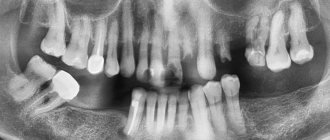Why does pathological formation occur?
The main reason for the development of the pathological process is injury to the soft tissue of the gums. The disease also often develops against the background of:
- Caries.
- Inflammation of the gum pocket.
- Violation of the rules of oral hygiene.
- Infectious diseases: tonsillitis, furunculosis, etc.
Pathology is characterized by gradual development:
- The initial stage is characterized by the appearance of mild pain when touching the gums.
- In the second stage, swelling and redness of the gums develop, and the pain becomes intense.
- If left untreated, pus appears in the gum pocket, body temperature rises, and swelling spreads to the cheek.
- Next, an extensive inflammatory process develops, characterized by the appearance of acute throbbing pain and an increase in the area of edema. The patient's general condition deteriorates significantly.
What is flux
Flux or periostitis is not a cosmetic defect; the gums and cheeks become swollen due to a damaged tooth, even if external signs of decay are not noticeable. The cause is always an infection that has entered the dental tissue as a result of caries, mechanical damage, sore throat, gum inflammation, etc.
Pathology develops against the background of poor oral hygiene - food remains between poorly brushed teeth, they rot, bacteria enter the surrounding bone and soft tissue, and cause inflammation. Similarly, infection occurs with caries.
Dental treatment
Types of disease
Flux is classified according to its development into the following types:
- Odontogenic. Pathology occurs against the background of advanced diseases of teeth and gums,
- Hematogenous. The disease develops when infection penetrates through the circulatory system.
- Lymphogenic. The cause of the disease is pathogenic microorganisms in the lymphatic system.
- Traumatic. Flux occurs at the site of injury to the periosteum, often after unsuccessful dental procedures during dental treatment.
According to the degree of spread, the following types of disease are distinguished:
- An ordinary flux that does not affect the periosteum.
- Fibrous flux, characterized by the onset of inflammation in the tissues of the periosteum.
- Orthodogenic flux, which develops as a complication - osteomyelitis, which requires tooth extraction.
- Albuminous flux, characterized by a chronic course, subfertile temperature and the occurrence of suppuration.
Causes of pathology
Before we tell you how to rinse flux, let’s explain why it occurs. Among the main reasons:
- progressive caries, when microorganisms from the resulting cavity penetrate the pulp and roots;
- poor-quality filling of teeth and canals;
- decreased immunity;
- inflammatory gum disease that has a chronic course;
- dominance of pathogenic microflora in the oral cavity.
It is necessary to establish the cause of the disease and only then treat it. Then the risk of flux recurrence will be much lower.
Diagnostic methods and treatment methods
An accurate diagnosis is a guarantee of successful treatment. To do this, the doctor conducts the necessary examination. It includes a diagnostic examination and fluoroscopy. To assess the degree of the inflammatory process, laboratory blood tests are performed.
There are two methods of flux treatment used in dentistry:
- Making an incision on the gum to open the purulent sac. After removing the pus, drainage is installed, which prevents premature healing.
- Cleaning an abscess through a root canal. This procedure is carried out when the cause of the flux is caries or the infection has penetrated through an existing crack in the tooth.
Special rinses are effective in treating flux. Solutions have regenerating and anti-inflammatory properties, therefore they can speed up healing. The simplest composition that can be used for rinsing with flux is a soda solution. If you carry out the procedure every couple of hours, you can quickly reduce pain and inflammation. To prepare the composition, dissolve a couple of teaspoons of soda in a glass of warm water. This amount of solution is enough for a day.
You can reduce swelling with a weak solution of manganese. This composition has strong disinfectant properties, which makes it possible to fight pathogenic microorganisms. For a similar effect, you can use the antiseptic agents Chlorhexedine or Miramistin. These drugs need to be used to irrigate the oral cavity.
An effective medicinal preparation for rinsing is Rotokan. It has a natural composition and contains extracts of chamomile, yarrow and calendula. For the solution, one spoon of the product is dissolved in a glass of warm water. Rinsing is carried out 4-5 times a day.
How is tooth flux treated?
If the cause of the inflammatory process is a diseased tooth, then at the first stage the question of the possibility of preserving it is resolved. Our experienced specialists will do everything to avoid removal.
Treatment usually involves five stages:
- first: the doctor, under local anesthesia, removes all tissues affected by caries, old fillings and creates direct access to the tooth canals
- second – removal of the nerve and determination of the length of the root canal
- third - expansion of the root canal of the tooth to gain access to its deeper areas
- fourth - installation of a paste containing calcium into the canal to stop acute inflammatory processes.
- fifth – temporary filling of the root canal
If necessary, an incision is made in the gum, the pus is removed and drainage is installed. For tooth flux in an adult, the doctor may also prescribe antibiotics or other drug therapy. In three to seven days you will need to come back for a follow-up appointment. If the doctor sees that there is no pus, the abscess is completely stopped, and the swelling of the cheek has subsided, he will seal the dental canal. The final stage of treatment will be the restoration of the crown of the tooth.
Recommendations after opening the flux
When the first symptoms of flux development appear, you should not self-medicate. It is a mistake to believe that swelling and pain can be relieved with warm compresses, lotions based on herbal infusions or other folk remedies. Independent experiments aimed at combating flux can lead to complications.
It is important to remember that you should not take painkillers less than 3 hours before visiting the dentist. Otherwise, there will be problems with making a diagnosis. After the tooth flux has been exposed, you should not take aspirin, as it increases the risk of bleeding. If after 12 hours the condition has not improved, you should consult a doctor immediately.
Why you can’t treat gumboil yourself
Periostitis is a purulent disease. If treated incorrectly, it often causes dangerous complications. Therefore, dentists do not recommend that patients self-medicate. You can understand that the pathology has begun to progress rapidly by the following symptoms:
- severe weakness, increased physical fatigue;
- heat;
- severe swelling;
- headache;
- inability to chew food due to pain;
- facial distortion due to tumor.
With such symptoms, rinsing alone will not help. You need to urgently go to the doctor.
Prevention
Understanding what gumboil is, you need to monitor the condition of your teeth and gums. Prevention consists of following hygienic rules for caring for the oral cavity. It is important to buy a quality toothbrush and good toothpaste to minimize the risks of developing caries. You need to brush your teeth twice a day: morning and evening.
After eating, it is necessary to remove food debris from the interdental spaces and use a mouth rinse to treat the oral cavity. To do this, you can buy the product at the pharmacy or prepare it based on propolis tincture, sea or table salt.
It is important to visit the dentist twice a year for preventive examinations. All diseases at the initial stage are successfully treated. Tartar should be removed regularly. It is in these deposits that pathogenic bacteria multiply, which, if the soft gum tissue is accidentally injured, can cause the development of gumboil.
To strengthen your gums, you must include fresh fruits and vegetables in your daily diet: apples, carrots, etc. They clean plaque on tooth enamel, which reduces the likelihood of tartar formation.
How to recognize developing flux
The sooner you start taking action, the better your chances of saving the tooth and avoiding surgery. Flux is far from harmless; neglected suppuration sometimes ends in sepsis with all the ensuing consequences.
Even before the tumor appears, characteristic symptoms appear:
- Weakness.
- Fever.
- Throbbing pain radiating to the head and ears.
- Inflammation of the lymph nodes.
- Bleeding and sore gums.
- Bad breath.
- Pain while chewing.
If you ignore the ailment, in the hope of being patient and cured with folk remedies, one day an asymmetrical tumor of the face will definitely appear.
As a rule, the mucous membrane around the tooth swells first, and a lump forms on the gum. After the flux has matured, a tumor forms on the lips, cheek, and under the eye if a tooth from the top row is diseased. When a tooth in the lower jaw is affected, swelling of the cheek and chin on one side is observed.
In children and the elderly, the symptoms do not appear as clearly as in middle-aged and young people, but the danger of pus penetrating into the body tissues is very high at any age.
Sometimes the flux becomes chronic, the tumor periodically appears and falls off. If a person does not see a doctor, the bone over the lesion gradually thickens and the inflammatory process continues. Poor oral hygiene and caries, as well as hypothermia, can provoke the formation of gumboil.
Attention! Do not under any circumstances try to puncture a swollen gum or squeeze pus out of it - you can introduce an infection into the surrounding tissue, and this is fraught with serious consequences.
Infected connective tissue becomes loose and soft. Severe pain appears, which can go away on its own or after painkillers. However, getting rid of discomfort does not mean that the infection is defeated - it sinks deeper and destroys the tooth root.
Take care of your teeth
Important rules for treatment
During treatment you should follow several tips:
- Flux cannot be cured by rinsing alone;
- It is not recommended to prepare the rinse in advance, and the prepared solution should be used at a time;
- you cannot increase the dosage of the drug, you must strictly follow the prescription so as not to cause harm;
- water for use should be warm, not hot;
- sodium bicarbonate should be added immediately to warm water, not to boiling water and cooled;
- You should not drink or eat food for at least half an hour after the procedure.
Sodium bicarbonate is a universal remedy that has no contraindications. But there are still cases when its use is prohibited:
- You cannot rinse the mouth of a small child with a soda solution, as he does not yet know how to spit out the liquid and may swallow the product.
- You should not use baking soda immediately after surgery or tooth extraction, as rinsing prevents the formation of a blood clot, which is necessary to protect the wound.
- It is not recommended to use this remedy for stomach ulcers.
Recommended for you:
Thermopsis cough tablets with soda: what helps and how to take them correctly at home
Following these recommendations, the treatment will proceed without complications.









